Perhaps my most dear hobby is to keep snakes and frogs. As a biologist this
reminds me of the world we tend to forget when you live in a city, as I do.
Also when you see a young fish less then 1 mm alive, computers seem less advanced...
I try to keep the frogs at least in an environment that is as natural as possible. That means running water, lots of plants, fish in the water and so on.
Therefore I have chosen to keep small frogs that will breed easily. I started with Mantella's as the first link shows. They have all died however in a period of 1.5 years. I only had eggs once. Therefore I have changed to the poisen frogs Epipedobates tricolor. They are lively during the day, and I have breeding success! Pictures are posted below.
I also had two Garter snakes (Tamnophis Sirtalis Sirtalis) three years old. Take a look at the links.
Tricolor (poison dart frog)
Here are some pics of my new paludarium setup (2003). It is unique in that it has shores, designed to let a swimming frog climb out of the water. It is always a big drawback to have large waters with small-frogs, since they can easily drown: they cannot find the shore and keep swimming toward light, which can come from all kinds of directions in a paludarium. Ususally they keep swimming in the corners.
The frogs do actually climb out of the water as I have witnessed many times. There are several places, as you can see for instance on the fifth and fourth picture.
This paludarium has all the advantages:
- Deep water with fish, which looks very nice and also makes sure all kinds of insects do not burry themselves in the ground. Also tadpoles can mature there, which does mean getting rid of too large fish that might eat them.
- Running water, so the tank cleans itsselve (bacteria do actually). I only clean the windows now and then. This is als the drawback: the windows get calcium stains.
- Different spots that are more dry or wet, since the water does not run everywhere, and only seaps through at some places.
The last photo on the second row proves the frogs bread. Here you see the male carry the tadpoles to the water. Also the two pics after that show the same. The rest of the pics show the frogs hiding in plants or watching over a banana where the fruit-flies usually gather. The levels in the paludarium are made of glas, with peat on it with moss and then plants. Of course there are bromelia's for the egs to be layed in them. There is also some foam used, in the upper-parts, which is also covered wit peat, which the frogs use to hide under.
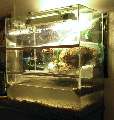
|

|

|

|

|

|

|
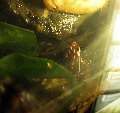
|
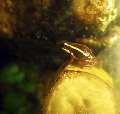
|

|
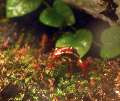
|
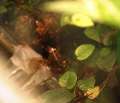
|

|

|
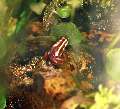
|

|

|
|||
Here are new pics from new frogs. After years of snake-charming I have given my snakes away (they would not reproduce) and started again with tricolor frogs. Until now the new setup seems a success: there are tadpoles in the water. Here are some close-ups.
 |
 |
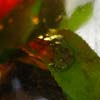 |
 |
 |
 |
 |
Below are older pictures of tadpoles and small poisen dart frogs. The pics of the eggs and frog-fish give some great detail. The closed up frog is my first home-bred frog: his or her name is "Hansje". First the pics of the eggs, the tadpoles, the new-bred frog Hansje. The second series is more about the paludarium (terrarium with water).

|

|
|

|

|
|
|

|

|

|

|

|

|

|
Here my fruit-fly recept, or rather the recept to make something fruit-flies can breed on:
- Take a jam-jar or something similar
- Some little peaces of brown bread upto 2 cm's or more
- Add vitamins-powder for frogs
- Add sugar (a spoon full)
- Add yoghurt, thick if you have it and not too-much. The mix should not become a liquid.
- Add peaces of carton above the substrate, so that flies can sit there and worms can climb on it to become pupea.
The yoghurt keeps it sterile, the bread has the yeast in it and the vitamins and bread make it nutricious. Works like a charm for me, never had problems with fungus. Don't forget to add fruitflies to start with:-)
More tricolor pics here, and more of times gone by.
Those were the frogs. Here are also some frog pictures, but mostly in the paludarium.
The first row of pics shows Hansje and his parents in the "wild". The second row shows firstly my red-eye tree frog.
The rest of the pics feature two paludaria I used to own. The last three pics are the small one, the rest the large one.
The small one is for youngh frogs, the large one for the rest.
The small paludarium has no running water, but it does have a slope, and it is filled with peat and moss. This is supposed to be good for the frogs. The slope is so that the water drains to the water part. I have glued (with silone) parts of bamboo to that slope in the width to stop the peat and moss from sliding in the water. I try to spray everyday half a liter of water over the peat and plants. As you can see I have taken care of it that plants grow in and out of the water. This is to keep frogs from drowning.
The large paludarium, featured in most pics has running water. I glued a tank with some foam (the white stuff used as packing for computers and electronics) and also used foam that comes out of a spraycan. Both materials are potentially dangerous to the frogs, so you need to be really careful. I have cut the packing foam with a knife, and then lightlky burned the outside with a candle. Then I painted it with gloss paint while spraying the wet paint with sand. If you do this carefully, you can get real rock-like things, that weigh nothing.
The sprays foam makes most of the rocks that are on top of the others and is also in the water as an island (which is glued to the bottom with silicone). The spray foam is also painted, and covered with sand.
Of course paint, silicone and so on are bad for the frogs. Therefore I have taken care to spay the foam in small layers, so it can harden well. Also the paint has been dryed a long time. Besides that the water that is running through the paludarium has been used to clean everything for two weeks. Refreshing the water about ten times. If there are any leftover chemicals the bacteria in the soil (sand with different sizes of rocks) in the water will take care of it. This is not true for silicon and heavy metals, which is why you must refresh the water a lot in the beginning. Of course I also refresh the water (50% every month) and "vacuum" the organic stuff that collects itsself in the deeper parts of the tank.
As I mentioned the soil in the water is made of sand and little pebbles in different sizes. I try to make deeper and less deep parts in it to increase diversity. I also use a spotlight to make sure the back of the water gets light as well, but not everywhere the same amount.
The paludarium has a pump that pumps the water up the foam, that is covered with moss. This way the frogs are alsways moist. The pump lays on the bottom of the tank, but in a plastic tray (the stuff you buy crickets in) to make sure the pebbles do not get in the pump. Apart form the moss there are a lot of differen plants. I prefer plants that branch easily, and that kind of lay half in the water and half above.
The lighting is covered by one small TL for frogs that is in the tank, and a bulb that is outside the tank. The bulb is used to regulate temperature. The large amount of water tends damp large temperature changes.
Of course there are a lot of fish in the water abnd they breed like hell: guppies and platties. The tadpoles do not seem to bother them and the other way around. I wouldn't go for fish that are much larger though if they also eat meat.

|

|

|

|

|

|

|

|

|

|

|

|

|

|

|
Breeding of the frogs goes well. There are bromelias where the eggs are laid in. I hang the bromelias in an old sock, covering the roots with moss. I have made sure that there is sufficient hiding place for the frogs, and also that there are two bromelias, for different males. They are calling all the time. When the male starts to transport tadpoles to the water I jump in and take some to the water in the small tank.
There is no need for "breeding spots" with this kind of frogs, they do their breeding in the bromelias. You must keep the bromelias wet however. You also have to make sure they are above water, if possible. The frogs prefer that in my tank at least.
I use fish food for the tadpoles, normal as well as special fish food for small growing fish. I also give them red and white mosquito larvae, and other worm-like larvae I can get at the fish pet-shop. The more different stuff you have the better. Also algea will grow to feed them.
The frogs are fed mostly with fruitflies and sometimes small crickets. I also add springtales and louse if I can find them. I do not always have food in thew tank, once in a while they must wait half a week. This is good for the females, because they tend to breed theirselves to death if they get the chance.
The temperature is 22-24 degrees C, and they get a day of 12 hours light. I must add that the males call more when i leave the curtains closed now and then.

